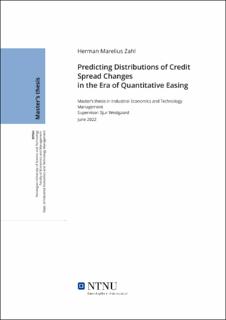| dc.contributor.advisor | Westgaard, Sjur | |
| dc.contributor.author | Zahl, Herman Marelius | |
| dc.date.accessioned | 2022-12-08T18:19:25Z | |
| dc.date.available | 2022-12-08T18:19:25Z | |
| dc.date.issued | 2022 | |
| dc.identifier | no.ntnu:inspera:116271940:116280703 | |
| dc.identifier.uri | https://hdl.handle.net/11250/3036874 | |
| dc.description.abstract | Flere modeller for prediksjon av fremtidige fordelinger av kredittspread-endringer er spesifisert og testet. Modeller bestående av prinsipalkomponenter fra risikofri rentekurve og kredittspreadkurve viser seg å være signifikant bedre enn andre testede modeller. Å legge til andre variabler i prinsipalkomponent-modellene svekker prediksjonevnen, noe som indikerer at informasjonen i kurvenes prinsipalkomponenter er tilstrekkelig for å predikere kredittspreader. Et unntak fås ved å legge til variabler knyttet til den amerikanske sentralbankens ukonvensjonelle pengepolitikk i perioden. Disse variablene bedrer prediksjonen av halene til fordelingen. Funnene i oppgaven har implikasjoner for generell modellering av kredittspreader og risikostyring i foretak, ettersom hele fordelingen av kredittspreader er hensyntatt. Videre generaliseres tidligere funn i litteraturen til å gjelde andre kvantiler i fordelingene. | |
| dc.description.abstract | Numerous models for predicting the future distribution of credit spread changes are specified and tested. Parsimonious factor models consisting of principal components of the risk-free and credit spread term structure are shown to significantly outperform other models. Additional market variables weaken the prediction performance, indicating that the information contained in the credit spread term structure and the risk-free term structure to a large degree span a sufficient set of information for credit spread predictions. One exception is the introduction of variables to account for unconventional monetary policies by the Fed in the time period. These variables are found to improve predictions for tails of the distributions of credit spread changes. The findings have implications for the modelling of credit spread changes and risk management, as the whole distribution is considered. Furthermore, earlier results in the literature are generalized to other quantiles of the distributions. | |
| dc.language | eng | |
| dc.publisher | NTNU | |
| dc.title | Predicting Distributions of Credit Spread Changes in the Era of Quantitative Easing | |
| dc.type | Master thesis | |
